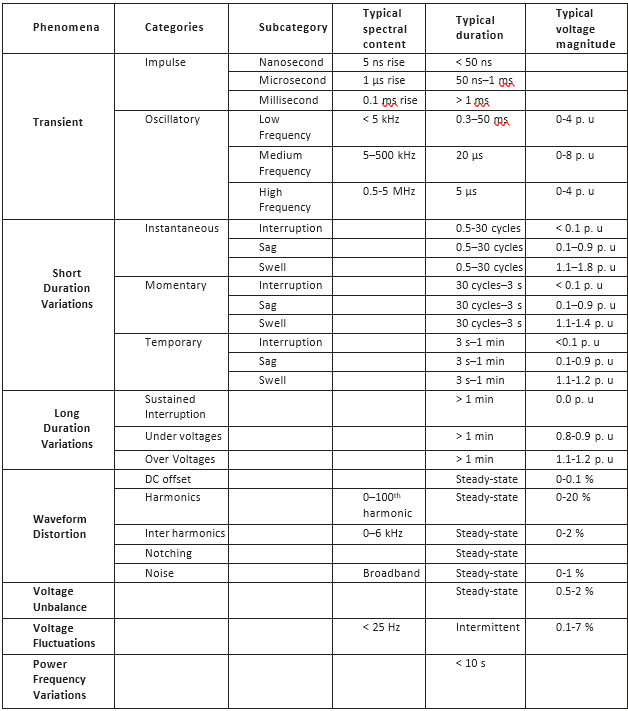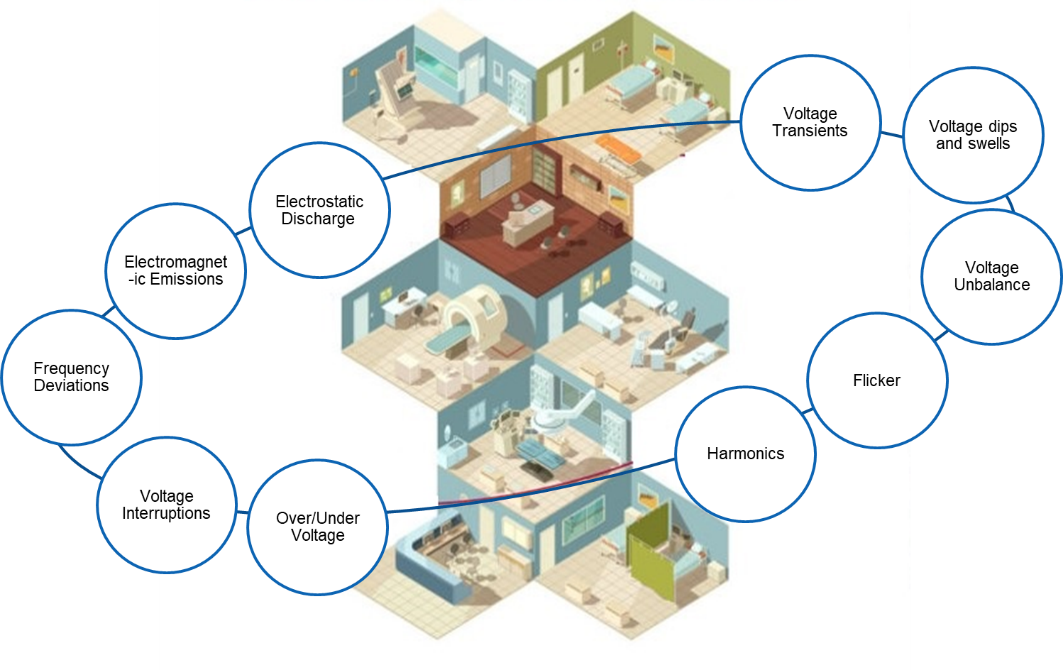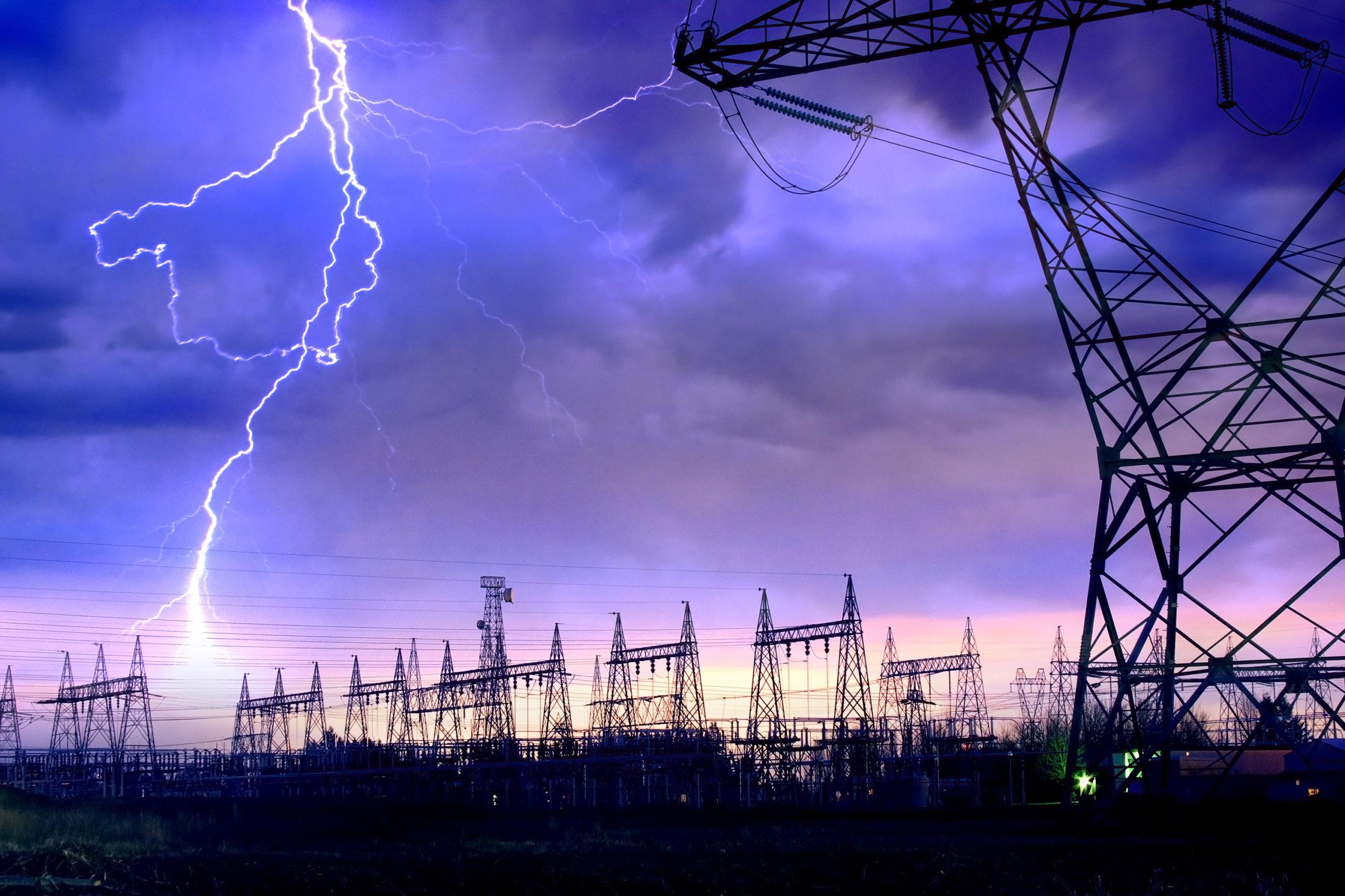Power Quality is defined in many sources, which give different meanings to different people and sometimes conflicting statements of Power Quality due to a lot of confusion on the meaning of the term Power Quality.
Therefore, its definition is not universally agreed upon. It is used synonymously with supply reliability, service quality, voltage quality, Quality of supply, and quality of consumption.
IEEE (Institute of Electrical and Electronics Engineers) dictionary states that “Power Quality is the concept of powering and grounding sensitive equipment in a manner that is suitable to the operation of that equipment”.
As per IEC (International Electro-Technical Commission) , 61000-4-30 states “Characteristics of the electricity at a given point on an electrical system, evaluated against a set of reference technical parameters”.
In general power, quality is related to disturbances in Voltage, current, frequency, and power factor. Thus, terms like poor power quality mean that there is ample deviation from norms in the power supply that may cause equipment malfunction or failure.
POWER QUALITY EVENTS
Power quality phenomena can be divided into two types, which need to be treated differently. A characteristic of voltage or current (frequency or power factor) is never exactly equal to its nominal or desired value. The small deviations from the nominal or desired value are called voltage variations or current variations.
Occasionally the voltage or current deviates significantly from its normal or ideal wave shape. These sudden deviations are called events.
Interruptions: A voltage interruption, supply interruption or just interruption is a condition in which the voltage at the supply terminals is close to zero. Close to zero as defined by the IEC (International Electro-Technical Committee) is lower than 1% of the declared voltage and by the IEEE (IEEE Std. 1159:1995) is lower than 10%.
Under Voltages: Under voltages of various duration are known under different names. Short duration under voltages is called voltage sags or voltage dips. Long duration under voltage is normally simply referred to as under voltage. According to the IEC, a supply voltage dip is a sudden reduction in the supply voltage to a value between 90% and 1% of the declared voltage, followed by a recovery between 10 ms and 1 minute later. For the IEEE, a voltage drop is only a sag if the during sag voltage is between 10% and 90% of the nominal voltage.
Over Voltages: Over voltage, events are also given different names based on their duration. Overvoltages of very short duration and high magnitude are called transient over voltages, voltage spikes, or sometimes voltage surges. The latter term is rather confusing as it is sometimes used to refer to Overvoltages within a duration of about 1 cycle and 1 minute. The latter event is more correctly called voltage swell. Longer duration over voltages is simply referred to as over voltages.
Transients: Transients are two types.
• Impulsive transients: An impulsive transient is a sudden, non-power frequency change in the steady-state condition of voltage, current, or both, that is unidirectional in polarity (primarily either positive or negative).
• Oscillatory transients: An oscillatory transient is a sudden, non-power frequency change in the steady-state condition of voltage, current, or both, that includes both positive and negative polarity values. An oscillatory transient consists of a voltage or current whose instantaneous value changes polarity rapidly.
Voltage unbalance: Voltage unbalance is sometimes defined as the maximum deviation from the average of the three-phase voltages or currents, divided by the average of the three-phase voltages or currents, expressed in percent. Imbalance can also be defined using symmetrical components. The ratio of either the negative- or zero sequence components to the positive sequence component can be used to specify the percent unbalance.
Waveform distortion: Waveform distortion is defined as a steady-state deviation from an ideal sine wave of power frequency principally characterized by the spectral content of the deviation. There are five types of waveform distortion. They are DC Offset, Harmonics, Interharmonics, Notching, and Noise
• DC Offset: The presence of a dc voltage or current in an ac power system is termed DC Offset.
• Harmonics: Harmonics are sinusoidal voltages or currents having frequencies that are integer multiples of the frequency at which the supply system is designed to operate. Distorted waveforms can be decomposed into a sum of the fundamental frequency and the harmonics. Harmonic distortion originates in the nonlinear characteristics of devices and loads on the power system.
• Interharmonics: Voltages or currents having frequency components that are not integer multiples of the frequency at which the supply system is designed to operate (e.g., 50 Hz or 60 Hz) are called Interharmonics. They can appear as discrete frequencies or as a wide-band spectrum.
• Notching: Notching is a periodic voltage disturbance caused by the normal operation of power electronics devices when current is commutated from one phase to another. The frequency components associated with notching can be quite high and may not be readily characterized with measurement equipment normally used for harmonic analysis.
• Noise: Noise is defined as unwanted electrical signals with broadband spectral content lower than 200 kHz superimposed upon the power system voltage or current in phase conductors or found on neutral conductors or signal lines.
Power frequency variations: Power Frequency Variations are defined as the deviation of the power system’s fundamental frequency from its specified nominal value (e.g., 50 Hz or 60 Hz).
Voltage fluctuations Voltage fluctuations are systematic variations of the voltage envelope or a series of random voltage changes, the magnitude of which does not normally exceed the voltage ranges specified by ANSI C84.1 (American National Standard for Electric Power Systems and equipment) of 0.9 pu to 1.1 pu. Loads, which can exhibit continuous, rapid variations in the load current magnitude, can cause voltage variations that are often referred to as flicker. The term flicker is derived from the impact of the voltage fluctuation on lamps such that they are perceived to flicker by the human eye.
The Power Quality parameters listed above can be summarized as shown in the given table.

For more information on how to keep your premises fire safe, please write to us at [email protected]




